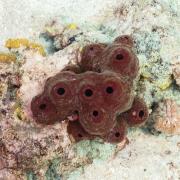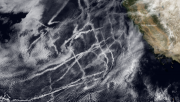Radio Program
Our regular Science and the SeaTM radio program presents marine science topics in an engaging two-minute story format. Our script writers gather ideas for the radio program from the University of Texas Marine Science Institute's researchers and from our very popular college class, Introduction to Oceanography, which we teach to hundreds of non-science majors at The University of Texas at Austin every year. Our radio programs are distributed at to commercial and public radio stations across the country.
A rare species of sponge found in the Red Sea and Indian Ocean has a rare distinction: It has levels of a metal that are thousands of times higher than ever seen in any other organism. And most of that metal is stored away by a type of bacteria that lives inside the sponge.
Sponges are filter feeders—they draw in water, filter out food and other solid bits, then shoot the water and solid particles back into the sea. Some contaminants can lodge inside them. Some studies have found high levels of arsenic, barium, and other toxic substances.
The journey around Cape Horn, at the southern tip of South America, is one of the most treacherous in the world. The cape has claimed hundreds of ships and thousands of sailors. Not many commercial vessels make the journey today. But for sail-powered yachts, rounding the cape is a big attraction—like climbing Mount Everest.
Cape Horn is named for the home town of the Dutch navigator who described it, in 1616. It’s a small island that features a cliff a quarter of a mile high.
The coconut crab is the 800-pound gorilla of many tropical beaches. Not only is it the biggest and strongest crab on land, it’ll eat just about anything—animal, vegetable, or even mineral.
It looks like something a six-year-old dreamed up in art class—the body of a fish, the “wings” of a bird, the legs of a crab, and even the taste buds of a human tongue. Throw in some loud croaks and grunts, and you’ve got one of the ocean’s many oddities: the sea robin.
A steep change in the slope of a riverbed can create rapids—regions where the water is especially fast and choppy—and dangerous. The same thing applies to rivers in the sky. Steep changes in altitude, temperature, or pressure can concentrate the water, creating rapids. They can cause downpours that are especially fast and heavy—and dangerous.
The great white shark has the most fearsome reputation of all sharks. But it might not be the biggest of the predator sharks. That honor might go to the Pacific sleeper shark. The biggest one ever seen appeared to be about 23 feet long—longer than the biggest great white.
The Pacific sleeper is found mainly in cold waters around the rim of the northern Pacific Ocean. But some have been seen in warmer waters close to the equator.
Currents at the bottom of the ocean can be just as fickle as wind currents at the surface. They can turn, speed up or slow down, and even reverse course. And they can change in just days or even hours.
That’s the conclusion of the most detailed study of sea-floor currents to date. Researchers anchored 34 instrument packages across a thousand-square-mile region off the coast of Mozambique, at the southeastern corner of Africa. The instruments monitored the currents for four years.
In the spring of 1956, a doctor in the Japanese village of Minamata reported an outbreak of a troubling new disease. It was seen mainly among children, and it affected the central nervous system. The disease quickly spread, with hundreds of cases reported, then thousands. It took years for scientists to work out the cause: poisoning from industrial pollution in Minamata Bay—the first known case of a disease caused by polluted seawater.
The parrotfish is like a house cleaner who does a great job of keeping things tidy, but sometimes breaks a glass. You want to keep them around, but you just wish they’d be a little less destructive.
For the parrotfish, the “houses” are coral reefs. They clean tiny organisms off the coral, keeping the coral healthy. But they also chip off pieces of the coral. If they chip away too much, they can damage the coral.
Parrotfish have strong teeth. They grind up the coral they chip off, then poop it out as grains that can wash up on the beach as white sand.
The exhaust produced by ocean-going ships can contribute to our warming climate. Most ships burn fossil fuels, so they spew out atmosphere-warming compounds. But some of their contribution to global warming may be a result of lower emissions—not of carbon, but of sulfur.












